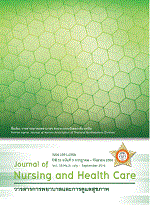การพัฒนาระบบการพยาบาลผู้ป่วยเด็กโรคหืด ในโรงพยาบาลสรรพสิทธิประสงค์ อุบลราชธานี
คำสำคัญ:
การพัฒนา ระบบการพยาบาล ผู้ป่วยเด็ก โรคหืด development, nursing system, pediatric patients, asthmaบทคัดย่อ
การวิจัยเชิงปฏิบัติการนี้ มีวัตถุประสงค์เพื่อพัฒนาระบบการพยาบาลผู้ป่วยเด็กโรคหืดและศึกษาผลลัพธ์ของ
การนำระบบที่พัฒนาแล้วมาใช้ในการพยาบาลผู้ป่วยเด็กโรคหืด ในโรงพยาบาลสรรพสิทธิประสงค์ อุบลราชธานี
ผู้ร่วมวิจัย ประกอบด้วย ผู้ป่วยเด็กโรคหืดและผู้ดูแลผู้ป่วย กลุ่มละ 60 คน พยาบาลที่ให้การพยาบาลผู้ป่วยเด็กโรคหืด
จำนวน 60 คน รวบรวมข้อมูลโดยการสังเกต สัมภาษณ์ สนทนากลุ่ม และใช้แบบสอบถาม ระหว่างเดือน เมษายน พ.ศ.
2557 ถึง สิงหาคม พ.ศ. 2558 ออกแบบการวิจัยเป็นการวิจัยเชิงปฏิบัติการ ของ Kemmis & McTaggart
มี 4 ขั้นตอน คือ 1) วิเคราะห์สถานการณ์ปัญหา จากการรวบรวมและวิเคราะห์ข้อมูลมาสะท้อนและระดมสมองในคณะ
กรรมการพัฒนาระบบการพยาบาลผู้ป่วยเด็กโรคหืดเพื่อวางแผนพัฒนา 2) ลงมือปฏิบัติตามแผน โดยจัดตั้งทีมพยาบาล
ผู้จัดการรายกรณี ร่วมกันพัฒนาแนวปฏิบัติการพยาบาลผู้ป่วยเด็กโรคหืด จัดระบบมอบหมายงานและกำหนดบทบาท
ของพยาบาลผู้จัดการรายกรณีและทีมการพยาบาล 3) สังเกตการปฏิบัติตามแผน ได้แก่ การปฏิบัติตามบทบาทของ
พยาบาลผู้จัดการรายกรณีและทีมการพยาบาล การส่งต่อการดูแลต่อเนื่อง 4) สะท้อน ผลการปฏิบัติ โดยเก็บและวิเคราะห์
ข้อมูลการปฏิบัติตามแนวปฏิบัติการพยาบาลผู้ป่วยเด็กโรคหืด ข้อมูลผลลัพธ์ของการพัฒนาทั้งด้านโรงพยาบาลและด้าน
ผู้ป่วย การวิเคราะห์ข้อมูล ข้อมูลเชิงคุณภาพ ใช้การวิเคราะห์เนื้อหา ข้อมูลเชิงปริมาณวิเคราะห์โดยใช้สถิติเชิงพรรณนา
ผลการวิจัย พบว่า ระบบการพยาบาลผู้ป่วยเด็กโรคหืด ประกอบด้วย บุคลากรพยาบาล การจัดระบบการ
พยาบาล และสถานที่ อุปกรณ์/เครื่องมือที่สนับสนุนการพยาบาล ระบบการพยาบาลช่วยให้เกิดช่องทางการติดต่อ
ประสานงานระหว่างหน่วยงาน ทีมพยาบาลผู้จัดการรายกรณีและทีมสหสาขาวิชาชีพ พยาบาลผู้จัดการรายกรณี
และทีมการพยาบาลได้รับการเสริมสร้างศักยภาพและพัฒนาสมรรถนะเชิงวิชาชีพส่งผลให้มีความรู้ ความมั่นใจใน
การดูแลและการให้คำแนะนำแก่ผู้ป่วย/ผู้ดูแล สามารถปฏิบัติตามบทบาทหน้าที่ได้เป็นอย่างดี การดูแลผู้ป่วยมีความ
ต่อเนื่อง ครอบคลุม ส่งผลให้ผู้ป่วยมีอัตราการ Re-Admit ลดลงจากร้อยละ 9.4 เหลือ 0.8 อัตราการ Re-visit ใน
72 ชั่วโมง ที่ ER ลดลงจากร้อยละ 12.9 เหลือ 5.6 การปฏิบัติตามแนวปฏิบัติการพยาบาลฯที่แผนกผู้ป่วยนอก
และผู้ป่วยในอยู่ในระดับมาก ( = 2.0,1.82 ตามลำดับ) ผู้ดูแลมีความรู้ในระดับสูง ( = 7.8) มีคะแนนการดูแลที่
บ้านในระดับมาก ( = 3.62) และเพิ่มขึ้นจากก่อนการพัฒนาอย่างมีนัยสำคัญทางสถิติที่ระดับ .012 และ.001 ตาม
ลำดับ รวมทั้งพึงพอใจในการดูแลในระดับมากที่สุด ( = 4.76) พยาบาลมีความรู้ในการพยาบาลในระดับปานกลาง
( = 6.40) และเพิ่มขึ้นจากก่อนการพัฒนาอย่างมีนัยสำคัญทางสถิติที่ระดับ 0.00
This action research aimed to develop a nursing system for pediatric patients with asthma and to study the outcomes of the developed system in Sanpasitthiprasong Hospital, UbonRatchathani. Study participants included 60 pediatric patients with asthma and their caregivers and 60 nurses. Data were collected by observations, in-depth interviews, focus - group discussion and questionnaire during April 2014 to August 2015. Research regulation of Kemmis & McTaggart was used in operating procedure, included four steps; 1) Analyzing
problem situation and gathering the all results, refl ection and brainstorming 2) Creating the plan: This step was preceded by setting up nurse case manager team to develop the Clinical Nursing Practice Guideline of pediatric patients with asthma. Then nurse case manager and nursing team were assigned and defi ned the roles following the guidelines. 3) Noticing and performing: This step consisted of the performance of nurse case manager and nursing team, completion of the performance as the Clinical Nursing Practice Guideline and
forwarding the continuing care. 4) Refl ecting the result of the operation: This step was preceded by collecting and analyzing data of the performance as the Clinical Nursing Practice Guideline. The result of the development from both the hospital staffs and the patients. The data were analyzed by using content analysis for qualitative data and descriptive statistics for quantitative data.
The research outcomes revealed that the nursing system for pediatric patients with asthma developed in this study consisted of 1) nursing staff 2) the management of nursing system, 3) tools/ equipment supported the nursing system. The nursing system helped in the case of contacting and cooperating between the departments, nurses case manager and multidisciplinary team. Nurse case manager and nursing team were supported potentiality and developed professional performance to gain the knowledge and confi dence in taking
care and giving advice to the patients. There was a continuation in patient care which resulted in the lower rate of re-admit from 9.4% to 0.8%. The rate of re-visit during 72 hours in E.R became lower from 12.9% to 5.6%. The practice for pediatric patients with asthma as the Clinical Nursing Practice Guideline at the outpatient department and inpatient department was in a good level ( = 2.0,1.82 respectively). The knowledge of caregivers was in a high level ( = 7.8), and home health care scores was in a good level ( = 3.62), the scores increased signifi cantly at .012 and .001 respectively after the development. The satisfaction in caring was in a good level ( = 4.76). The nursing knowledge development of nurses was in a moderate level (= 6.40),and increased signifi cantly at 0.00



